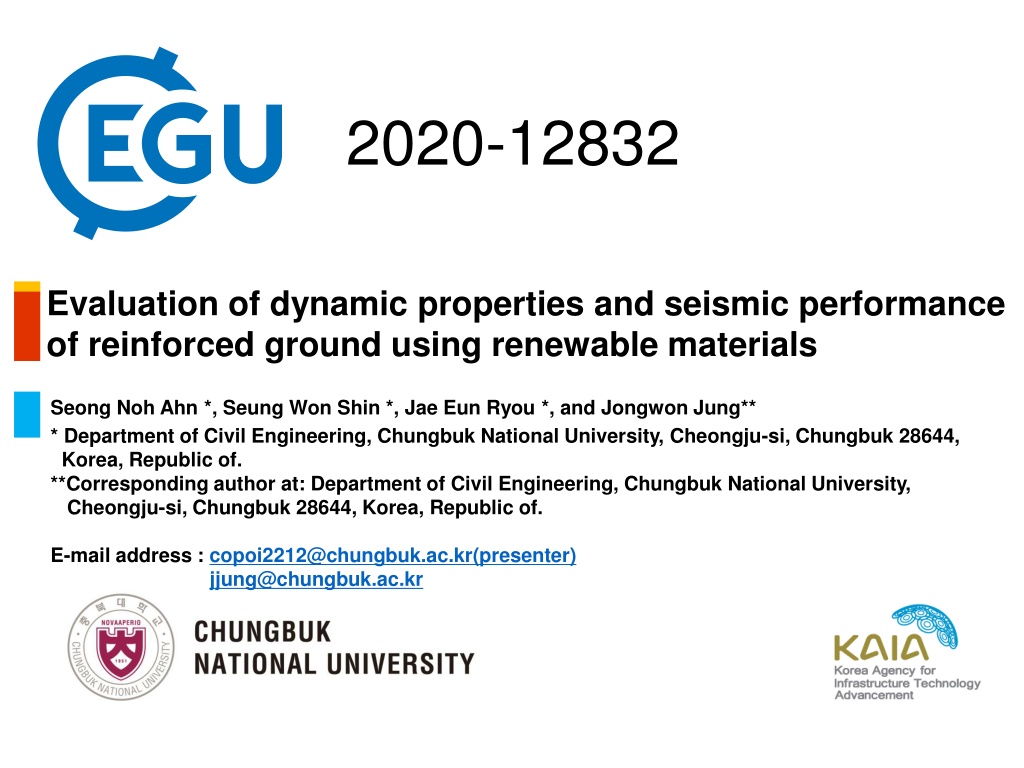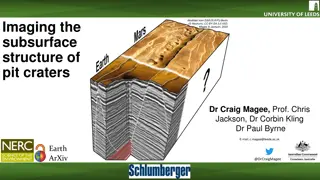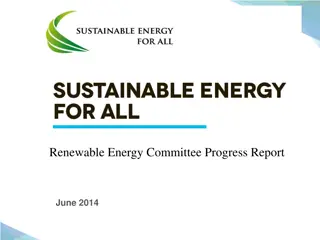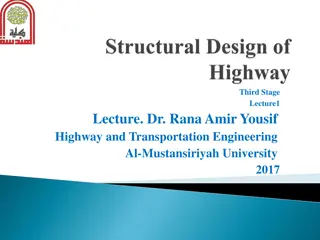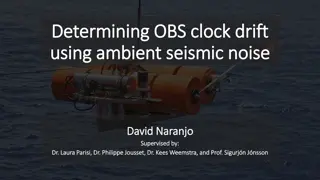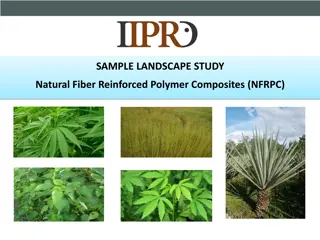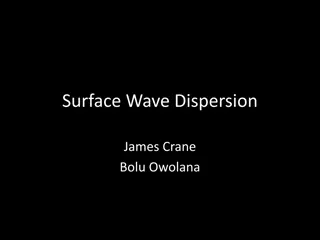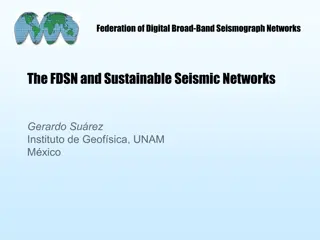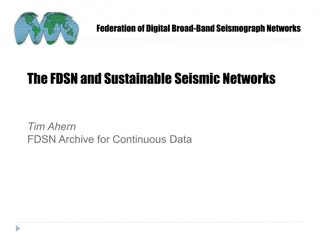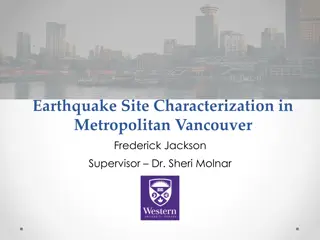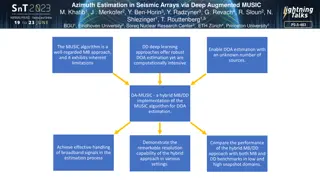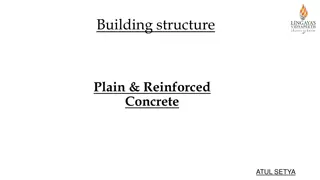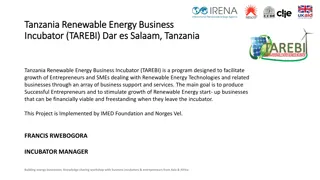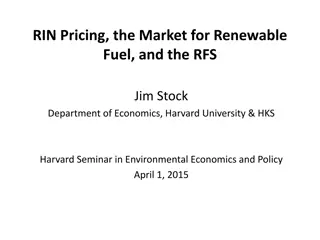Evaluation of Dynamic Properties and Seismic Performance of Reinforced Ground Using Renewable Materials
Improvement of seismic performance through improved dynamic properties of ground using renewable materials like cement and biopolymer is crucial for reducing earthquake-induced structural damage. This study conducted resonant column tests to assess the enhanced dynamic properties of soil and utilized equivalent linear response analysis to explore the improvement in seismic performance. The use of biopolymer Sodium Alginate was compared with cement to reinforce the soil. Results showed an increase in shear modulus with higher cement content and significant enhancements with the addition of 0.6% and 3% Sodium Alginate.
Download Presentation

Please find below an Image/Link to download the presentation.
The content on the website is provided AS IS for your information and personal use only. It may not be sold, licensed, or shared on other websites without obtaining consent from the author. Download presentation by click this link. If you encounter any issues during the download, it is possible that the publisher has removed the file from their server.
E N D
Presentation Transcript
2020-12832 Evaluation of dynamic properties and seismic performance of reinforced ground using renewable materials Seong Noh Ahn *, Seung Won Shin *, Jae Eun Ryou *, and Jongwon Jung** * Department of Civil Engineering, Chungbuk National University, Cheongju-si, Chungbuk 28644, Korea, Republic of. **Corresponding author at: Department of Civil Engineering, Chungbuk National University, Cheongju-si, Chungbuk 28644, Korea, Republic of. E-mail address : copoi2212@chungbuk.ac.kr(presenter) jjung@chungbuk.ac.kr
Introduction Improvement of seismic performance is necessary to reduce structural damage caused by earthquakes. Improving the dynamic properties of the ground on which the structure is located can improve the seismic performance. Therefore, in this study, the soil was mixed with cement and biopolymer to improve of the dynamic properties of the ground. Thus, the resonant column tests were performed to estimate the improved dynamic properties of soil and equivalent linear response analysis was conducted to explore improvement of seismic performance. Ground surface Bed rock 2
Testing material Biopolymer - Sodium Alginate Previous studies were conducted to improve the dynamic properties of the soil for eco- friendly method due to environmental problems were on the rise. Biopolymer which is a powder type material that made by natural material can help reinforce soil when mixed with the soil in the form of solution. In this study, the improved dynamic properties of soil were compared using sodium alginate and cement. 3
Testing device Resonant column test The dynamic properties of soil vary nonlinearly with shear strain. Test methods exist to estimate the dynamic properties of soil according to the range of shear strain. The Resonant column test can estimate the dynamic properties of the soil in the initial linear section to the nonlinear section according to the shear strain. Initial linear Nonlinear Resonant column test 4
Ground response analysis Equivalent linear response analysis Earthquake waves amplify when pass through the ground until reach the ground surface. The amplification of earthquake waves is influenced by the dynamic properties of the ground and in order to predict that Ground response analysis shall be performed using the dynamic properties of the site. The equivalent linear response analysis conduct the nonlinear dynamic properties of the ground through iterative calculations. Ground surface Bed rock 5
Results and Analysis As the cement content increased, the maximum shear modulus increased, and the sodium alginate content of 0.6% increased by about twice than 0% and content of 3% increased 18% than content of 0%. Normalized shear modulus curves were reduced linear section and moved to the left as the cement and sodium alginate content increased. The damping ratio curves were reduced linear section and minimum damping ratio increased. 6
Results and Analysis Equivalent linear response analysis was performed using the dynamic properties of ground by the resonant column test. The input seismic waves applied Hachinohe(long period wave)and Ofunato(short period wave). As the cement content increased, the peak ground acceleration decreased by up to 50% and the peak ground acceleration of sodium alginate content of 0.6% increased by about 2% than content of 0%, but at content of 3%, the peak ground acceleration decreased by up to 13% 7
Conclusion The maximum shear modulus of soil increases when soil are mixed with cement and sodium alginate The Reduced linear section of normalized shear modulus curve is expected to destruction of cementation in soil pore The cementation in soil pore caused energy dissipation and increased the damping ratio Improved soil using cement and sodium alginate results in the decreased the peak ground acceleration. 8
References Dookie Kim, Dynamics of Structures, 4th Edition, ISBN:9788982254581, Goomi Book, August 2017. Acar Y. B. and El-Tahir A. E.(1986). Low strain dynamic properties of artificially cemented sand . Journal of Geotechnical Engineering, 112(11), 1001 1015 Chang, I., Im, J.(2016), Dynamic properties of gellan treated sands using resonant column tests , Advances in Civil, Environmental, and Materials Research(ACEM16) Seed, H. B. and Idriss, I. M.(1970) Soil moduli and damping factors for dynamic response analyses, Earthquake Engineering Research Center , Report No.EERC 70-10 Vucetic, M. and Dobry, R.(1991), Effect of soil plasticity on cyclic response, Journal of Geotechnical Engineering, Vol. 117, (1), pp. 89-107. Kramer strven L., Geotechnical Earthquake Engineering, Prentice-hall inc. 1996. Seungcheol Baek, Jundae Lee, Kwangkuk Ahn.(2013), Evaluation of Shear Elastic Modulus by Changing Injection Ratio of Grout, Journal of the Korean Geo-Environmental Society 14(2), 2013.2, 51-55(5 pages) Acknowledgement This work is supported by the Korea Agency for Infrastructure Technology Advancement(KAIA) grant funded by the Ministry of Land, Infrastructure and Transport (Grant 20CTAP-C152100-02). Also, This research was supported by a grant(2018-MOIS31-009) from Fundamental Technology Development Program for Extreme Disaster Response funded by Korean Ministry of Interior and Safety(MOIS). 9
